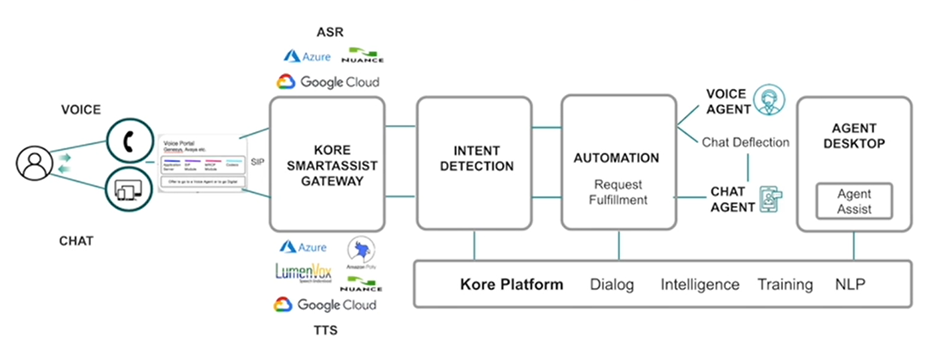SmartAssist is an automation-first, customer intent-driven contact center solution. It is available in the cloud and on-premises deployment modes and provides an intuitive, omnichannel solution for inbound customer service.
Built on top of the Kore.ai XO Platform, SmartAssist brings together an enterprise-grade automation platform and a full-featured Agent Desktop to serve the range of services that a modern customer demands.
With SmartAssist, you can design consistent customer experiences based on intents. For example, you can choose to direct regular customer queries through an automation-based approach to reduce customer wait times and improve customer satisfaction. You can also direct customers to a human agent based on your business rules and customer preferences or deflect them from voice to chat seamlessly.
SmartAssist allows you to set up a cloud contact center, choosing to integrate your existing telephony or build from scratch. You can also deploy chat on your website to meet your customers wherever they are.
How it Works
The following flow diagram illustrates SmartAssist’s high-level architecture.
The general workflow is given below.
A customer makes a call or initiates a chat interaction at a customer service endpoint.
For calls:
- A call goes through the Kore SmartAssist Voice gateway, which is processed through an Automated Speech Recognition (also known as Speech-to-Text) engine to convert a customer’s voice input to text.
- The Kore NLU engine processes this text to understand what the customer is saying and is either processed with an automated dialog, an agent transfer, or a deflection from voice to chat.
- In case of an automated dialog, the Bot’s text-based response to the end customer’s input is converted back to voice and relayed to the customer through the SmartAssist voice gateway. Customers can also be routed to an agent if the virtual assistant cannot handle a customer’s intent.
- In case of an agent transfer, the call is routed to an available agent (based on the routing logic defined within SmartAssist) and managed by the Voice gateway. At this point, two primary flows happen, one is the automation flow, and the other is the agent flow.
- Finally, in case of deflection, the end customer receives a message on a text-based channel (SMS, WhatsApp, etc.) to continue the conversation over text (SMS). This is particularly useful when a customer needs to update an address (and an error is far less likely than via voice).
For chat based channels:
- The system directly routes an end customer’s intent to SmartAssist, where the intent is detected. Based on the configurations, SmartAssist decides to let a Bot handle a conversation or transfer it to a human agent.
- In the case of automation, the virtual assistant does its best to fulfill the customer’s request based on the use case and within the customer’s preferred channel.
- In the case of a live agent, SmartAssist transfers the chat to an available agent on the customer’s channel based on the routing logic specified for that particular intent.
Once the call or chat transfers to an agent, agents can use the SmartAssist Agent Desktop to interact with the end customers.
While using the agent desktop, customers can access the Agent Assist Bot, which helps answer customer queries based on customer context and intents.
